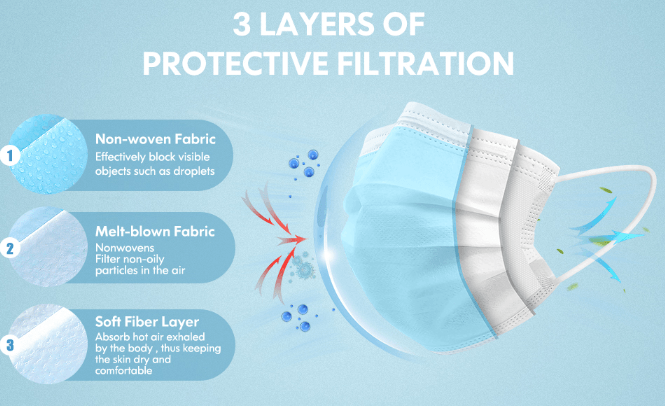The importance of the medical face mask can not be ignored with the entrance of PPE in the public since the Covid-19 began. Wellmien Healthcare who is the medical face mask manufacture will make some explanations for you.
Medical masks (also called surgical masks) are composed of three layers of synthetic non-woven materials. They are a kind of mask that can cover the nose and mouth of the user and provide a physical barrier for liquid and particulate materials. It is also called a medical surgical mask and is considered a medical device.Medical masks are also personal protection, used to protect the wearer from airborne particles and liquids to contaminate the face.
Medical masks are designed for single-use and should be disposed of properly after one wear. A medical-grade mask must have at least a 95% droplet filtration system, breathability and consist of multiple layers of manufactured, non-woven materials such as polypropylene, polyethylene or cellulose.
If worn correctly, medical masks help block large droplets, splashes, sprays or splashes that may contain viruses and bacteria, and prevent them from entering the wearer’s nose and mouth.
Medical masks are worn by operating room personnel during surgical procedures. They protect both the patients and operating room staff from the transfer of:
lbodily fluids
lmicro-organisms
lparticulate material

There are many classifications under the international standards for surgical mask based on the different test as below.
lBacterial Filtration Efficiency
lParticulate Filtration efficiency
lDifferential Pressure for breath ability
lSynthetic Blood Penetration for Face Masks
lMicrobial Cleanliness for Face Masks
lFlammability for medical masks
lEN 14683: 2019 +AC : 2019 TYPE II
lEN 14683: 2019 +AC : 2019 TYPE IIR
lASTM F2100-2019 ASTM Level 1, Level 2 and level3
ASTM standards are referenced by the Food and Drug Administration (FDA), as the endorsed standard in the United States. ASTM F2100 specifies the performance requirements for Medical Face Masks with five basic criteria:
1. BFE (Bacterial Filtration Efficiency): BFE measures how well the medical face mask filters out bacteria when challenged with a bacteria-containing aerosol. ASTM specifies testing with a droplet size of 3.0 microns containing Staph. Aureus (average size 0.6-0.8 microns). In order to be called a medical/surgical mask, a minimum 95% filtration rate is required. Moderate and high protection masks must have bacterial filtration rates greater than 98%.
Some manufacturers use the Modified Greene & Vesley method to determine the BFE rating. This method is NOT recommended by ASTM for product comparison or evaluating consistency.
2. PFE (Particulate Filtration Efficiency): PFE measures how well a hospital mask filters sub-micron particles with the expectation that viruses will be filtered in a similar manner. The higher the percentage, the better the mask filtration. Although testing is available using a particle size from 0.1 to 5.0 microns, ASTM F2100 specifies that a particle size of 0.1 micron be used.
When comparing test results it is important to note the size of the test particles used, as use of a larger particle size will produce a misleading PFE rating.
3. Fluid Resistance: Fluid resistance reflects the surgical mask’s ability to minimize the amount of fluid that could transfer from the outer layers through to the inner layer as the result of a splash or spray. ASTM specifies testing with synthetic blood at pressures of 80, 120, or 160 mm Hg to qualify for low, medium, or high fluid resistance. These pressures correlate to blood pressure: 80 mm Hg = venous pressure (Level 1), 120 mm Hg = arterial pressure (Level 2), and 160 mm Hg (Level 3) correlates to potential high pressures that may occur during trauma, or surgeries that include high pressure irrigation such as orthopedic procedures.
4. Delta P (Pressure Differential): Delta P measures the air flow resistance of the medical mask and is an objective measure of breathability. The Delta P is measured in units of mm H2O/cm2 and the lower the value the more breathable the mask feels. The ASTM standard requires that masks have a Delta P of less than 6.0 for moderate and high barrier masks, whereas low barrier masks must have a Delta P of less than 5.0.
5. Flame Spread: As hospitals contain sources of oxygen, heat, and fuel the ASTM standards include testing for flame resistance. Testing dictates that all hospital masks must withstand exposure to a burning flame (within a specified distance) for three seconds. All PRIMED masks meet this requirement.
5.5 ISO Certification: In addition to the above tests, all medical face masks must be tested to an international standard (ISO 10993-5, 10) for skin sensitivity and cytotoxic tests to ensure that no materials are harmful to the wearer. Tests are conducted on materials used in construction of the mask which come in contact with the user's skin.
For more information about medical masks, please do not hesitate to contact our experts.